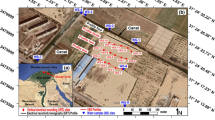Abstract
Descriptions of the surface–groundwater interactions are required for enhanced water resource management in the irrigation canals of the Kerian Scheme. The current study aims to find the hidden aquifer, determine the water loss/gain in an irrigation system, and identify the hydraulic interconnection between aquifer systems using geophysical, water balance, and stable isotope methods. The Resistivity Image Profiling (RIP) method is a common geophysical survey technique used to find a potential groundwater bearing zone in the study area. RIP results show that the thickness of the aquifer varies between 5 and 10 m at a depth of 10–30 m. The results are compared against borehole drilling data. Water loss and/or water gain in an irrigation system is an important component of the water balance for planning and operation. The water level at the Selinsing Canal system increases, clearly indicating that the catchment is very responsive to rainfall events. The use of stable isotopes to trace water movement in hydrology, including surface water and groundwater, is an important task within the environmental field. Thus, the results plotted for both water samples from Selinsing Canal and groundwater are linearly similar to those in the Global Meteoric Water Line and the Malaysian Meteoric Water Line. Thus, the samples are revealed to come from evaporated samples. This indicates that there is a connection between the surface and the groundwater in the catchment area.
Similar content being viewed by others
References
Abbas A, Ahmad A, Akbar S (2009) Understanding surface-ground water connectivity using water balance and geoelectrical resistivity techniques. In: 18th World IMACS/MODSIM congress, Cairns, Australia
Al-Ruwaih FM, Shehata M (2004) Hydrochemical processes and environmental isotopic study of groundwater in Kuwait. Water Int 29(2):158–166
ANCID (2003) Open channel seepage and control-best practice guidelines for channel seepage identification and measurement, vol 1.4. Australian National Committee on Irrigation and Drainage, Victoria, Australia, http://www.ancid.org.au/pdf/seepReports141003/Vol1.4_Guidelines.pdf
Asghar MN, Khan MA, Lashbrook B, Zumkley T, Lawson S (2011) Hotspots assessment of spatial water losses in the off-farm open channels irrigation supply system. Water Resour Manage 25:1281–1297
Ayub MS (2005) Malaysian meteoric water line: an input to isotopes hydrological studies. TAG Brown Bag Seminar No 1, Malaysia Institute for Nuclear Technology Research (MINT)
Berbel J, Mesa-Jurado MA, Piston JM (2011) Value of irrigation water in Guadalquivir Basin (Spain) by residual value method. Water Resour Manage 25:1565–1579
Chang LC, Ho CC, Yeh MS, Yang CC (2011) An integrating approach for conjunctive-use planning of surface and subsurface water system. Water Resour Manage 25:59–78
Chung YM, Syafalni S (2009) Estimation of water losses from the Selinsing Channel of Kerian irrigation scheme using water balance method. Unpublished technical paper, School of Civil Engineering, Universiti Sains Malaysia, Malaysia
Craig H (1961) Standard for reporting concentrations of deuterium and oxygen-18 in natural waters. Science 133:1833–1834
Dutta S, Krishnamurthy NS, Arora T, Rao VA, Ahmed S (2006) Localization of water bearing fractured zones in a hard rock area using integrated geophysical techniques in Andhra Pradesh, India. Hydrogeol J 14:760–766
Ewusi A, Kuma JS, Voigt HJ (2009) Utility of the 2-D multi-electrode resistivity imaging technique in groundwater exploration in the Voltaian sedimentary basin, Northern Ghana. Nat Resour Res 18(4):267–275
Gaye CB (2001) Isotope techniques for monitoring groundwater salinization. Hydrogeol J 9:217–218
Ghazalli MA (1998) Modernisation of irrigation and drainage management for agricultural production. Department of Irrigation and Drainage Malaysia, p 10
Jothiprakash V (2004) Water balance model to assess the water loss/gain in a river system. IE (I) Journal-CV 84:198–200
Kinzli KD, Martinez M, Oad R, Prior A, Gensler D (2010) Using an ADCP to determine canal seepage loss in an irrigation district. Agric Water Manag 97:801–810
Kneisel C (2006) Assessment of subsurface lithology in mountain environments using 2D resistivity imaging. Geomorphology 80:32–44
Lee TS, Najim MMM, Amirul MH (2004) Estimating evapotranspiration of irrigated rice at the West Coast of the Peninsular of Malaysia. J Appl Irrig Sci 39(1):103–117
Loke MH (1999) Electrical imaging surveys for environmental and engineering studies. A practical guide to 2D and 3D surveys. Advanced Geosciences, Austin, Texas, p 62
Montesinos P, Camacho E, Campos B, Rodriguez-Diaz JA (2011) Analysis of virtual irrigation water. Application to water resources management in a Mediterranean river basin. Water Resour Manage 25:1635–1651
Rowshon MK, Kwok CY, Lee TS (2003) GIS-based scheduling and monitoring of irrigation delivery for rice irrigation system Part I. Scheduling. Agric Water Manag 62:105–116
Samsudin AR, Rahim ABE, Wan Yaacob WZ, Hamzah U (2006) Mapping of contamination plumes at municipal solid waste disposal sites using geoelectric imaging technique: case studies in Malaysia. J Spat Hydrol 6(2):13–22
Song XM, Kong FZ, Zhan CS (2011) Assessment of water resources carrying capacity in Tianjin City of China. Water Resour Manage 25:857–873
SonTek/YSI Incorporated (2010) RiverSurveyor S5/M9 system manual. February 2010, http://www.sontek.com
Sophocleous M (2002) Interactions between groundwater and surface water: the state of science. Hydrogeol J 10:52–67
Soupios P, Loupasakis C, Vallianatos F (2008) Reconstructing former urban environments by combining geophysical electrical methods and geotechnical investigations—an example from Chania, Greece. J Geophys Eng 5:186–194
Swamee PK, Mishra GC, Chahar BR (2002) Design of minimum water-loss canal sections. J Hydraul Res 40(2):215–220
Valera A, Desa MNM (1991) Design-management interactions of Malaysia’s Kerian Irrigation Scheme. International Irrigation Management Institute, Colombo, Sri Lanka, p 64
Woessner WW (2000) Streams and fluvial plain ground water interactions: rescaling hydrogeologic thought. Ground Water 38(3):423–429
Yurtsever Y, Araguas L (1993) Environmental isotope applications in hydrology: an overview of the IAEA’s activities, experiences, and prospects. In: Tracers in hydrology, proceedings of the Yokohama symposium, July 1993, IAHS publ no 215
Zhang G, Deng W, Yang YS, Salama RB (2007) Evolution study of a regional groundwater system using hydrochemistry and stable isotopes in Songnen Plain, northeast China. Hydrol Process 21:1055–1065
Author information
Authors and Affiliations
Corresponding author
Rights and permissions
About this article
Cite this article
Dor, N., Syafalni, S., Abustan, I. et al. Verification of Surface-Groundwater Connectivity in an Irrigation Canal Using Geophysical, Water Balance and Stable Isotope Approaches. Water Resour Manage 25, 2837–2853 (2011). https://doi.org/10.1007/s11269-011-9841-y
Received:
Accepted:
Published:
Issue Date:
DOI: https://doi.org/10.1007/s11269-011-9841-y




